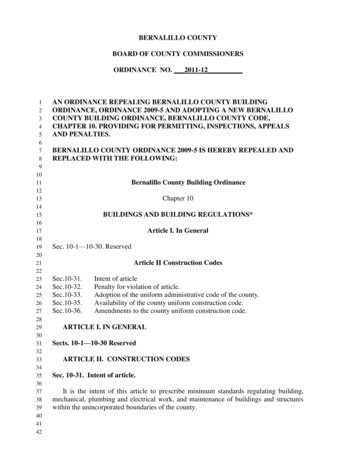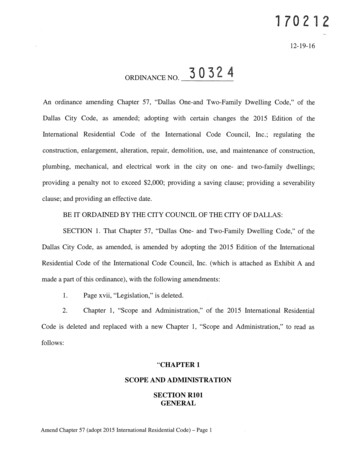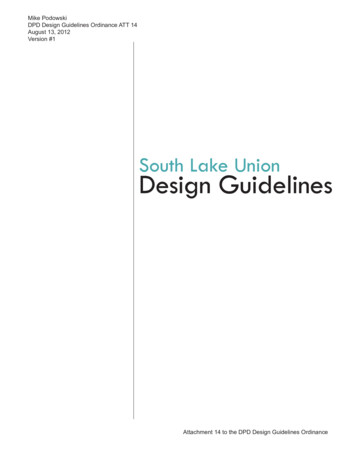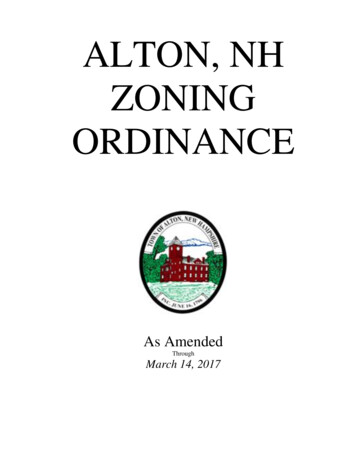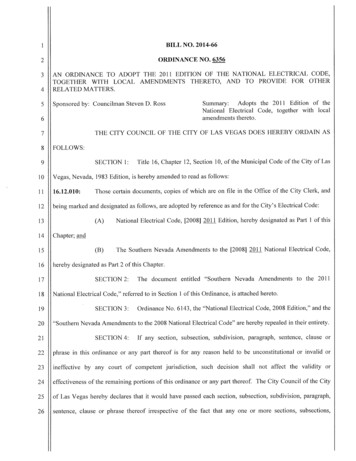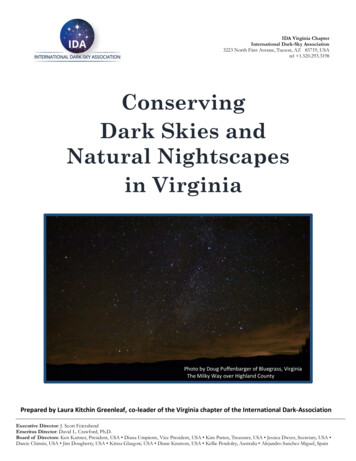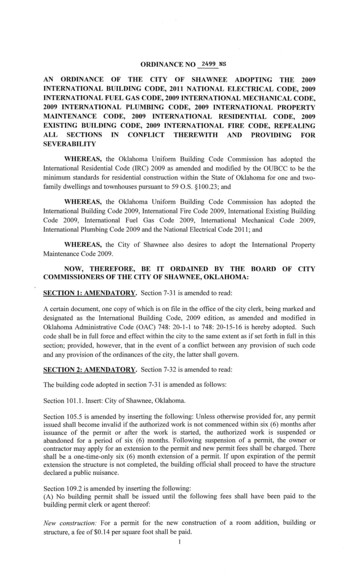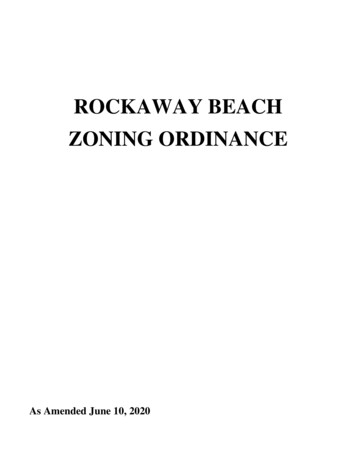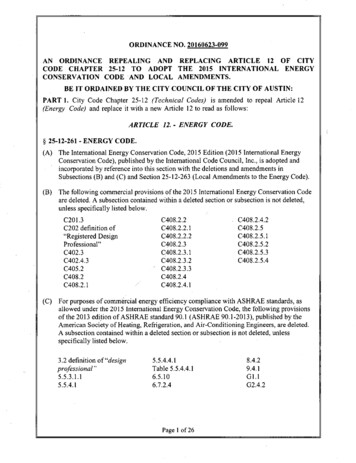
Transcription
ORDINANCE NO. 20160623-099AN ORDINANCE REPEALING AND REPLACING ARTICLE 12 OF CITYCODE CHAPTER 25-12 TO ADOPT THE 2015 INTERNATIONAL ENERGYCONSERVATION CODE AND LOCAL AMENDMENTS.BE IT ORDAINED BY THE CITY COUNCIL OF THE CITY OF AUSTIN:P A R T I . City Code Chapter 25-\2 (Technical Codes) is amended to repeal Article 12(Energy Code) and replace it with a new Article 12 to read as follows:ARTICLE 12. - ENERGY CODE.§ 25-12-261 - ENERGY CODE.(A) The International Energy Conservation Code, 2015 Edition (2015 International EnergyConservation Code), published by the International Code Council, Inc., is adopted andincorporated by reference into this section with the deletions and amendments inSubsections (B) and (C) and Section 25-12-263 (Local Amendments to the Energy Code).(B) The following commercial provisions of the 2015 International Energy Conservation Codeare deleted. A subsection contained within a deleted section or subsection is not deleted,unless specifically listed below.C201.3C202 definition of"Registered 408.2.3.2C408.2.3.3C408.2.4C408.2.4.1. 08.2.5.4(C) For purposes of commercial energy efficiency compliance with ASHRAE standards, asallowed under the 2015 International Energy Conservation Code, the following provisionsof the 2013 edition of ASHRAE standard 90.1 (ASHRAE 90.1-2013), published by theAmerican Society of Heating, Refi-igeration, and Air-Conditioning Engineers, are deleted.A subsection contained within a deleted section or subsecfion is not deleted, unlessspecifically listed below.3.2 definition of le 5.5.4.4.16.5.106.7.2.4Page 1 of 268.4.29.4.1GI.lG2.4.2
(D) The following residential provisions of the 2015 International Energy Conservation Codeare deleted. A subsection contained within a deleted section or subsection is not deleted,unless specifically listed below.R202 definition of"Residenfial Building"R402.1.2Table R402.1.2Table .3.4R403.9R404.1R405.2R405.3Table R405.5.2(l)R406.2R406.3Table R406.4§25-12-262 CITATIONS TO THE ENERGY CODE.In the City Code, "Energy Code" means the 2015 International Energy Conservation Codeadopted by section 25-12-261, as amended, including local amendments adopted by section 2512-263.§25-12-263 LOCAL AMENDMENTS TO THE ENERGY CODE.(A)The following provisions are local amendments to the commercial provisions of the 2015International Energy Conservation Code. Each provision in this subsection is a substitutefor an identically numbered provision deleted by Secfion 25-12-261(B) or an addifion tothe Energy Code.C201.3 Terms defined in other codes. Terms not defined in this Code that are defined in theBuilding Code, Electrical Code, Fire Code, Mechanical Code, the Plumbing Code, ResidentialCode or the Solar Code have the meaning ascribed to them in those codes.C202 GENERAL DEFINITIONS - REGISTERED DESIGN PROFESSIONAL. Anindividual who is registered or licensed to practice their respective design profession as definedby the statutory requirements of the professional registration laws of the state or jurisdiction inwhich the project is to be constructed.For the purposes of Section C408, System Commissioning, the term registered designprofessional shall be restricted to individuals who hold one of the following certifications:1. Association of Energy Engineers - Certified Building Commissioning Professional(CBCP);2. AABC Commissioning Group- Certified Commissioning Technician(CxT);3. American Society of Heating, Refiigeration and Air-Conditioning Engineers Commissioning Process Management Professional (CPMP);4. Building Commissioning Association - Certified Commissioning Professional (CCP);5. National Environmental Balancing Bureau (NEBB) - Building Systems Commissioning Certified Professional (BSC-CP)6. Licensure as a Registered Professional Engineer in the State of Texas.C402.2.7 Insulation encapsulation requirement. Insulafion (including but not limited to loosefill, spray applied cellularfiberinsulafion as well as other blanket and batts insulation) installedin assemblies more than 60 degreesfi-omthe horizontal must be in substantial contact with an airbarrier on all sides.Page 2 of 26
Exception: Air impermeable insulation. Air impermeable insulation is defined as:A material having an air permeance equal to or less than 0.02 L/s-m2 at 75 Pa pressuredifferential tested according to ASTM E2178 or E283.C402.3 Roof solar reflectance and thermal emittance. Low-sloped roofs directly abovecooled conditioned spaces in Climate Zones 1, 2 and 3 shall comply with one or more of theopfions in Table C402.3.Exceptions: The following roofs and portions of roofs are exemptfi-omthe requirements ofTable C402.3:1. Portions of the roof that include or are covered by the following:1.1. Photovoltaic systems or components.1.2. Solar air or water-heating systems or components.1.3. Roof gardens or landscaped roofs.1.4. Above-roof decks or walkways.1.5. Skylights.1.6. HVAC systems and components, and other opaque objects mounted above theroof1.7. Repairs to roof surfaces when the repair does not exceed the lesser of 50% of theroof surface or 20 squares (2000 sq ft).2. Portions of the roof shaded during the peak sun angle on the summer solstice bypermanent features of the building or by permanent features of adjacent buildings.3. Portions of roofs that are ballasted with a minimum stone ballast of 17 pounds persquare foot [74 kg/m ] or 23 psf [117 kg/m ] pavers.4. Roofs where not less than 75 percent of the roof area complies with one or more ofthe exceptions to this section.Roof surfaces with an incline greater than 2 units vertical in 12 horizontal shall incorporate aroof material having a minimum reflectance of 0.35 or a minimum initial SRI of 29.C402.4.3 Maximum U-factor and SHGC. The maximum U-factor and solar heat gaincoefficient (SHGC) for fenestration shall be as specified in Table C402.4.The window projection factor shall be determined in accordance with Equation 4-5.PF A/B (Equation 4-5)where:PF Projecfion factor (decimal).A Distance measured horizontally from thefiarthestcontinuous extremity of any overhang,eave or permanently attached shading device to the vertical surface of the glazing.B Distance measured verticallyfi-omthe bottom of the glazing to the underside of theoverhang, eave or permanently attached shading device.Page 3 of26
Where different windows or glass doors have different PF values, they shall each be evaluatedseparately.Exception: Where windows are required to comply with the visible transmittance (VT)requirement outlined in secfion 3.2.2.E, Glazing on Building Facades, of the City of Austin'sSubchapter E, Design Standards and Mixed Use ordinance, the solar heat gain coefficient(SHGC) requirement shall not apply. Instead, the window shall have a projecfion factor (PF) 0.5.C403.2.4.8 Overhead door HVAC shut-off devices. Overhead doors, cargo doors, slidingdoors, folding and accordion style wall systems, and other loading dock style doors that comprisepart of the building thermal envelope shall be equipped with a means for automafically shuttingoff the heating, cooling and humidity control equipment that serves the area or zone that includesthe door within 5 minutes of the door opening. The shut off shall activate prior to the door being25% open. A shut off override, designed to be used when vehicles are parked in the doorway,may be included on doors equipped with weather seals per secfion C402.5.6. The override mustautomafically deactivate when the vehicle is removed.Exceptions:1. Where HVAC equipment must remain on for safety, sanitation or other health relatedreasons.2. Radiant heafing systems.C403.2.18 Ventilation filtration and filtration of return air. Ventilation systems shallincorporate filtration having a minimum efficiency reporting value (MERV) rating of 6 orgreater. All return air as well as all air that is heated, cooled, or humidity controlled must bedrawn through the air filtration system.C403.2,19 Demand response. When Direct Digital Control is utilized, the controls shall havethe capability to remotely setup the operating cooling temperature set point in all non-criticalzones in response to signals, based on OpenADR 2.0 or higher protocols, from a centralizedcontact or software point. Controls may be programmed to provide either an automatic or anoperator adjustable degree of change for the temperature setup.C404.12 Electric water heater timers. For Group R buildings electric resistance water heatersmust be installed in conjunction with a preprogrammed water heater timer. The timer shall bepreprogrammed to turn the water heater off between the hours of 3:00 p.m. and 7:00 p.m. fi omJune 1 to September 30 and fi-om 12:00 a.m. to 4:00 a.m. throughout the year. Thefimershallhave a readily accessible override, as defined by the building official administrative rule, capableof restoring power to the water heater for one hour when activated.C405.2 Lighting controls (Mandatory). Lighfing systems shall be provided with controls asspecified in Secfions C405.2.1, C405.2.2, C405.2.3, C405.2.4, C405.2.5, and C405.2.6.Exceptions: Lighting controls are not required for the following:1. Areas designated as security or emergency areas that are required to be continuouslylighted.2. Interior exit stairways, interior exit ramps, and exit passageways.3. Emergency egress lighting that is normally off.Page 4 of 26
C405.2,6 Demand response. For all buildings having central control of a) lighting levels and/orb) the ability to turn on and off individual lamps, the controls shall have the capability to reducelighfing level in response to signals, based on OpenADR 2.0 or higher protocols,fi-omacentralized contact or software point. Controls may be programmed to provide either anautomatic or an operator adjustable degree of lighting reduction.C408.2 Mechanical systems and service water-heating systems commissioning andcompletion requirements. Prior to approval of the plans for permit, the registered designprofessional or approved agency shall provide evidence of mechanical systems commissioning inaccordance with the provisions of this secfion.Construction document notes shall clearly indicate provisions for commissioning and completionrequirements in accordance with this section and are permitted to refer to specifications forfijrther requirements. Copies of all documentation shall be given to the owner or owner'sauthorized agent and made available to the code official upon request in accordance withSections C408.3.4 and C408.3.5.Exceptions: The following systems are exempt:1. Mechanical systems and service water heater systems in buildings where the totalmechanical equipment capacity is less than 480,000 Btu/h (140.7 kW) coolingcapacity and 600,000 Btu/h (175.8 kW) combined service water-heating and spaceheating capacity.2. Systems included in Section C403.3 that serve individual dwelling units and sleepingunits.C408.2.1 Commissioning plan. A commissioning plan shall be developed by a registereddesign professional or approved agency and shall include the following items:1. A narrafive description of the acfivities that will be accomplished during each phase ofcommissioning, including the personnel intended to accomplish each of the activities.2. A listing of the specific equipment, appliances or systems to be tested and a descriptionof the tests to be performed.3. Functions to be tested including, but not limited to, calibrations and economizer controls,mechanical systems performance and efficiency measurement, and lighting systems persection C408.3.4. Conditions under which the test will be performed. Testing shall affirm winter andsummer design conditions and fiall outside air conditions.5. Measurable criteria for performance.C408.2.2 Commissioning form. A completed commissioning form shall be submitted to theplan review department during permitting in a format approved by the building official. TheCommissioning form will summarize the Owner's HVAC Project Requirements, provide a listingof the equipment and the quantity of equipment to be tested, and describe the equipmentsequences of operafions to be tested (or a reference to the sequence of operations included withthe construcfion drawings or specifications). A minimum of 20%) of the installed equipment shallbe tested in a manner consistent with standard engineering practices, but not less than 5 units.C408.2.3 Systems adjusting and balancing. HVAC systems shall be balanced in accordancewith generally accepted engineering standards. Air and water flow rates shall be measured andPage 5 of 26
adjusted to deliver final flow rates within the tolerances provided in the product specifications.Test and balance acfivifies shall include air system and hydronic system balancing.C408.2,3,l Air systems balancing. Each supply air outlet and zone terminal device shall beequipped with means for air balancing in accordance with the requirements of Chapter 6 of theInternational Mechanical Code. Discharge dampers used for air system balancing are prohibitedon constant-volume fans and variable-volume fans with motors 10 hp (18.6 kW) and larger. Airsystems shall be balanced in a manner to first minimize throttling losses then, for fans withsystem power of greater than 1 hp (0.746 kW), fan speed shall be adjusted to meet design flowconditions.Exception: Fans with fan motors of I hp (0.74 kW) or less are not required to be providedwith a means for air balancing.C408.2.3.2 Hydronic systems balancing. Individual hydronic heating and cooling coils shall beequipped with means for balancing and measuring flow. Hydronic systems shall beproportionately balanced in a manner to first minimize throttling losses, then the pump impellershall be trimmed or pump speed shall be adjusted to meet design flow conditions. Each hydronicsystem shall have either the capability to measure pressure across the pump, or test ports at eachside of each pump.Exceptions: The following equipment is not required to be equipped with a means forbalancing or measuring flow:1. Pumps with pump motors of 5 hp (3.7 kW) or less.2. Where throttling results in no greater than 5 percent of the nameplate horsepowerdraw above that required if the impeller were trimmed.C408.2.4 Functional performance testing. Functional performance testing specified in SectionsC408.2.4.1 through C408.2.4.3 shall be conducted.C408.2,4.1 Equipment. Equipmentfiancfionalperformance testing shall demonstrate theinstallafion and operation of components, systems, and system-to-system interfacingrelationships in accordance with approved plans and specifications such that operation, fianction,and maintenance serviceability for each of the commissioned systems is confirmed. Testing shallinclude all modes and sequence of operafion, including under full-load, part-load and thefollowing emergency conditions:1. All modes as described in the sequence of operation.2. Redundant or automafic back-up mode.3. Performance of alarms.4. Mode of operation upon a loss of power and restoration of power.Exception: Unitary or packaged HVAC equipment listed in Tables C403.2.3(l) throughC403.2.3(3) that do not require supply air economizers.C408.2.4.2 Controls. HVAC and service water-heating control systems shall be tested todocument that control devices, components, equipment and systems are calibrated and adjustedand operate in accordance with approved plans and specifications. Sequences of operafion shallbe functionally tested to document they operate in accordance with approved plans andspecifications.Page 6 of 26
C408.2.4.3 Economizers. Air economizers shall undergo afianctionaltest to determine that theyoperate in accordance with manufacturer's specifications.C408.2.5 Preliminary commissioning report. A preliminary report of commissioning testprocedures and results shall be completed and certified by the registered design professional orapproved agency and provided to the building owner or owner's authorized agent. The reportshall be organized with mechanical and service hot water findings in separate sections to allowindependent review. The report shall be identified as "Preliminary Commissioning Report" andshall identify:1. Itemization of deficiencies found during tesfing required by this secfion that have notbeen corrected at the time of report preparation.2. Deferred tests that cannot be performed at the time of report preparation because ofclimafic conditions.3. Climatic conditions required for performance of the deferred tests.C408.2.5.1 Acceptance. Systems, or portions thereof, required by the Energy Code to complywith this section shall not pass the final mechanical inspection until such time that the buildingofficial has received a letter, in a format approved by the building official, from theCommissioning Authority (CxA) or Engineer of Record (EGR) that includes one of thefollowing:1. Certification that all systems required to be commissioned meet the objecfives of theOwner's Project Requirements at the time of inspection, or2. A list, as of the approximate date of inspecfion, of outstanding issues with thecommissioned systems which the CxA or EGR believes fall short of the Owner's ProjectRequirements.The letter shall also include the name of the CxA or EOR as well as their qualification, foundwithin the definition of Registered Design Professional in secfion C202.C408.2.5.2 Copy of report. The code official shall be permitted to require that a copy of thePreliminary Commissioning Report be made available for review by the code official.C408.2.6 Documentation requirements. The construction documents shall specify that thedocuments described in this section be provided to the building owner or owner's authorizedagent within 90 days'of the date of receipt of the certificate of occupancy.C408.2.6.1 Drawings. Construction documents shall include the location and performance dataon each piece of equipment.C408.2.6.2 Manuals. An operating and maintenance manual shall be provided and include all ofthe following:1. Submittal data stafing equipment size and selected options for each piece of equipmentrequiring maintenance.2. Manufacturer's operation manuals and maintenance manuals for each piece of equipmentrequiring maintenance, except equipment not fiimished as part of the project. Requiredroutine maintenance actions shall be clearly identified.3. Name and address of at least one service agency.Page 7 of 26
4. HVAC and service hot water controls system maintenance and calibration information,including wiring diagrams, schematics and control sequence descriptions. Desired orfield-determined set points shall be permanently recorded on control drawings at controldevices or, for digital control systems, in system programming instructions.5. Submittal data indicating all selected opfions for each piece of lighting equipment andlighfing controls.6. Operation and maintenance manuals for each piece of lighting equipment. Requiredroufine maintenance actions, cleaning and recommended relamping shall be clearlyidentified.7. A schedule for inspecting and recalibrating all lighting controls.8. A narrative of how each system is intended to operate, including recommended setpoints.C408.2.6.3 System balancing report. A written report describing the acfivifies andmeasurements completed in accordance with Section C408.2.3.C408.2.6.4 Final commissioning report. A report of test procedures and results identified as"Final Commissioning Report" shall be delivered to the building owner or owner's authorizedagent. The report shall be organized with mechanical system, lighting, and service hot watersystemfindingsin separate sections to allow independent review. The report shall include thefollowing:1. Results of fiinctional performance tests.2. Disposition of deficiencies found during testing, including details of corrective measuresused or proposed.3. Functional performance test procedures used during the commissioning process includingmeasurable criteria for test acceptance, provided herein for repeatability.Exception: Deferred tests that cannot be performed at the time of report preparafion due toclimatic conditions.(B)For purposes of commercial energy efficiency compliance with ASHRAE standards, thefollowing provisions are local amendments to ASHRAE 90.1-2013. Each provision inthis subsection is a substitute for an identically numbered provision deleted by Section25-12-261(C) or an addition to the Energy Code.3.2 Definitions.design professional: An architect or engineer licensed to practice in accordance with applicablestate licensing laws.For the purposes of 6.7.2.4, HVAC System Commissioning, the term design professional shall berestricted to individuals who hold one of the following certifications:1. Association of Energy Engineers - Certified Building Commissioning Professional(CBCP);2. AABC Commissioning Group- Certified Commissioning Technician(CxT);Page 8 of26
3. American Society of Heafing, Refiigeration and Air-Conditioning Engineers Commissioning Process Management Professional (CPMP);4. Building Commissioning Association - Certified Commissioning Professional (CCP);5. National Environmental Balancing Bureau (NEBB) - Building Systems Commissioning-Certified Professional (BSC-CP)6. Licensure as a Registered Professional Engineer in the State of Texas.5.4.4 Roof Solar Reflectance and Thermal Emittance. Roofs in Climate Zones 1 through 3with a slope less than or equal to 2 units vertical in 12 horizontal shall have one of the following:a. A minimum three-year-aged solar reflectance of 0.55 and a minimum three-year-agedthermal emittance of 0.75 when tested in accordance with CRRC-1 Standardb. A minimum Solar Reflectance Index of 64 when determined in accordance with the SolarReflectance Index method in ASTM El980 using a convecfion coefficient of 2.1Btu/h-ft F, based on three-year-aged solar reflectance and three-year-aged thermalemittance tested in accordance with CRRC-1 StandardExceptions:1. Ballasted roofs with a minimum stone ballast of 17 Ib/ft or 23 Ib/ft pavers2. Vegetated roof systems that contain a minimum thickness of 2.5 in. of growing mediumand covering a minimum of 75% of the roof area with durable plantings3. Roofs where a minimum of 75%) of the roof areaa. is shaded during the peak sun angle on June 21 by permanent components or featuresof the building;b. is covered by offset photovoltaic arrays, building- integrated photovoltaic arrays, orsolar air or water collectors; orc. is permitted to be interpolated using a combination of 1 and 2 above4. Repairs to roof surfaces when the repair does not exceed the lesser of 50% of the roofsurface or 20 squares (2000 sq ft)5. Roofs over semiheated spaces, or roofs over conditioned spaces that are not cooledspacesThe values for three-year-aged solar reflectance and three-year-aged thermal emittance shall bedetermined by a laboratory accredited by a nationally recognized accreditation organization andshall be labeled and certified by the manufacturer.Roof surfaces with an incline greater than 2 units vertical in 12 horizontal shall incorporate aroof material having a minimum reflectance of 0.35 or a minimum initial SRI of 29.5.4.5 Insulation encapsulation requirement. Insulation (including but not limited to loose fill,spray applied cellular fiber insulafion as well as other blanket and batts insulation) installed inassemblies more than 60 degreesfi-omthe horizontal must be in substantial contact with an airbarrier on all sides.Exception: Air impermeable insulafion. Air impermeable insulation is defined asA material having an air permeance equal to or less than 0.02 L/s-m at 75 Pa pressuredifferenfial tested according to ASTM E2178 or E283Page 9 of 26
5.5.4.1 General. Compliance with U-factors, SHGC, and VT/SHGC shall be demonstrated forthe overall fenestration product. Gross wall areas and gross roof areas shall be calculatedseparately for each space-conditioning category for the purposes of determining compliance.Exceptions:1. If there are multiple assemblies within a single class of construcfion for a single spaceconditioning category, compliance shall be based on an area weighted average U-factor,SHGC, VT/SHGC, or LSG. It is not acceptable to do an area-weighted average acrossmultiple classes of construction or multiple space-conditioning categories.2. Where windows are required to comply with the visible transmittance (VT) requirementoutlined in section 3.2.2.E, Glazing on Building Facades, of the City of Austin'sSubchapter E, Design Standards and Mixed Use ordinance, the solar heat gain coefficient(SHGC) requirement shall not apply. Instead, the window shall have a projection factor(PF) 0.5.5.5.4.4.1 SHGC of Vertical Fenestration. Vertical fenestration shall have an SHGC not greaterthan that specified in Tables 5.5-1 through 5.5-8.Exceptions:1. For demonstrating compliance for south, east, or west-oriented vertical fenestrationshaded by opaque permanent projections that will last as long as the building itself, theSHGC of the shaded vertical fenestration in the proposed building is permitted to bereduced by using the mulfipliers in Table 5.5.4.4.1. Permanent projecfions consisfing ofopen louvers shall be considered to provide shading, provided that no sun penetrates thelouvers during the peak sun angle on June 21.2. For demonstrating compliance for south, east, or west-oriented vertical fenestrationshaded by partially opaque permanent projections (e.g.,ft-amingwith glass or perforatedmetal) that will last as long as the building itself, the projection factor (PF) shall bereduced by multiplying it by a factor of Os, which is derived as follows:Os (Ai X O.) (Af X Of)Where:Os percent opacity of the shading deviceAi percent of the area of the shading device that is a partially opaque infillOj percent opacity of the infill for glass Oj (100%) - Tj), where Ts is the solar. transmittance as determined in accordance with NFRC 300; for perforated ordecorafive metal panels, Oi percentage of solid materialAf percent of the area of the shading device that represents thefi-amingmembersOf percent opacity of theframingmembers; if solid, then 100%)The SHGC of the shaded vertical fenestration in the proposed building is permitted tothen be reduced by using the multipliers in Table 5.5.4.4.1 for each fenestrafion product.3. Vertical fenestrafion that is located on the street side of the street-level story only,provided thata. the street side of the street-level story does not exceed 20 ft in height,b. the fenestration has a confinuous overhang with a weighted average PF greater than 0.5,andc. the fenestration area for the street side of the street-level story is less than 75%) of thegross wall area for the street side of the street-level story.Page 10 of 26
When this exception is ufilized, separate calculations shall be performed for thesesections of the building envelope, and these values shall not be averaged with anyothers for compliance purposes. No credit shall be given here or elsewhere in thebuilding for not fiilly utilizing the fenestration area allowed.4. For dynamic glazing, the minimum SHGC shall be used to demonstrate compliance withthis section. Dynamic glazing shall be considered separately from other verticalfenestration, and area-weighted averaging with other vertical fenestration that is notdynamic glazing shall not be permitted.5. Vertical fenestration that is north-oriented shall be permitted to have an SHGC equal toor less than the area-weighted average SHGC of the south, east, and west-orientedvertical fenestrafion before any reductions made for permanent projections in Exceptions1 and 2 of Section 5.5.4.4.1.Table 5.5.4.4.1 SHGC Multipliers for Permanent ProjectionsProjection FactorSHGC Multiplier (South, East, WestOrientations)0-0.101.00 0.10-0.200.91 0.20-0.300.82 0.30-0.400.74 0.40-0.500.67 0.50-0.600.61 0.60-0.700.56 0.70-0.80.'0.51 0.80-0,900.47 0.90-I.OO0.446.4.3.10.4 Demand response. When DDC is utilized, the controls shall have the capability toremotely setup the operating cooling temperature set point in all non-critical zones in response tosignals, based on OpenADR 2.0 or higher protocols, from a centralized contact or software point.Controls may be programmed to provide either an automatic or an operator adjustable degree ofchange for the temperature setup.6.4.4.2.3 Ventilation filtration and filtration of return air. Ventilafion systems shallincorporate filtration having a minimum efficiency reporting value (MERV) rating of 6 orgreater. All return air as well as all air that is heated, cooled, or humidity controlled must bedrawn through the air filtration system.6.5.10 Door Switches. Any condifioned space with a door, including doors with more than onehalf glass, opening to the outdoors shall be provided with controls that, when any such door isopen,Page 11 of 26
a. disable mechanical heating or reset the heating setpoint to 55 F or lower within fiveminutes of the door opening andb. disable mechanical cooling or reset the cooling setpoint to 90 F or greater within fiveminutes of the door opening. Mechanical cooling may remain enabled if outdoor airtemperature is below space temperature.Exceptions:1. Building entries with automatic closing devices2. Any space without a thermostat3. Alterafions to existing buildings4. Loading docks5. Radiant heating systems6. Where HVAC equipment must remain on for safety, sanitafion, or other health relatedreasons6.7.2.4 HVAC SYSTEM COMMISSIONING6.7.2.4.1 General. This section covers the commissioning of the building mechanical systems inSecfion 6, Heating, Venfilating, and Air Conditioning.6.7.2.4.2 Mechanical systems and service water-heating systems commissioning andcompletion requirements. Prior to approval
CODE CHAPTER 25-12 TO ADOPT THE 2015 INTERNATIONAL ENERGY CONSERVATION CODE AND LOCAL AMENDMENTS. BE IT ORDAINED BY THE CITY COUNCIL OF THE CITY OF AUSTIN: PARTI. City Code Chapter 25-\2 (Technical Codes) is amended to repeal Article 12 . Terms not defined in this Code that are defined in the Building Code, Electrical Code, Fire Code .
